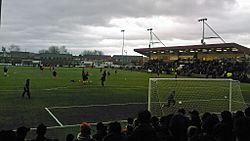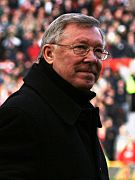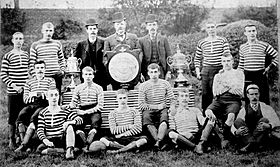East Stirlingshire F.C. facts for kids
 |
||
| Full name | East Stirlingshire Football Club | |
|---|---|---|
| Nickname(s) | The Shire | |
| Founded | 1 October 1880 (as Bainsford Britannia) |
|
| Ground | Falkirk Stadium, Falkirk | |
| Capacity | 7,937 | |
| Chairman | Simon Dickerson | |
| Manager | Pat Scullion | |
| League | Lowland League | |
| 2015–16 | Scottish League Two, 10th (relegated via play-offs) | |
|
|
||
East Stirlingshire Football Club, often called "The Shire", is a Scottish football team from Falkirk. They started in 1881, though their roots go back to 1880 when a local cricket club formed a football team called Bainsford Britannia. Today, they play in the Lowland League, which is the fifth level of Scottish football.
The club joined the Scottish Football League in 1900. For most of their history, they have played in this league system. East Stirlingshire has won the second level of Scottish football once and finished second once. Both times, they moved up to the top league. Their highest league position was during the two times they played in the top league, in 1932–33 and 1963–64. In 2016, East Stirlingshire was the first club ever to be moved out of the national league system.
East Stirlingshire first played in the Scottish Cup in 1882. Their best result was reaching the quarter-finals three times, most recently in 1981. In 2000–01, they reached the semi-finals of the Scottish Challenge Cup, but lost to Livingston. In 2008, the club left their old stadium, Firs Park. They moved to Ochilview Park to share it with local rivals Stenhousemuir. Since the 2018–19 season, they have shared the Falkirk Stadium with their neighbours, Falkirk.
Contents
- Club History: The Shire's Journey
- Team Colors and Club Crest
- Home Grounds: Where The Shire Plays
- Rivalries: Local Football Battles
- Current Team Squad
- Coaching Staff
- Famous Players of East Stirlingshire
- Notable Managers of East Stirlingshire
- Club Achievements (Honours)
- Records and Statistics
- See also
Club History: The Shire's Journey
East Stirlingshire officially began in 1881. But their story started a year earlier when a cricket club, Bainsford Bluebonnets, created a football team called Britannia. Their first recorded game was a friendly match against Falkirk's second team in December 1880. They lost that game 7–0. Their first game as East Stirlingshire was against the same team in August 1881. The club's nickname is "The Shire," which comes from the "Stirlingshire" part of their name.
After joining the Scottish Football Association, the club could play in the Scottish Cup. This is Scotland's main football knock-out competition. They were knocked out in their first game in 1882. In December 1883, the Stirlingshire Football Association was formed. This led to a new local tournament called the Stirlingshire Cup. The club reached the final in its first season. East Stirlingshire was very strong in this tournament early on. They won it four times in a row between 1885 and 1890. This included a big 9–0 win against Falkirk in the 1888 final. Lawrence McLachlan scored two goals in that game. He was a key player in the club's early success, scoring 135 known goals.
The late 1800s were East Stirlingshire's best years in the Scottish Cup. In 1888–89 and 1890–91, the club reached the quarter-finals. This was the last time for 91 years. They lost to Celtic and Hearts. In the 1888–89 tournament, they had their biggest wins. They beat local rivals Stenhousemuir 10–1 in the first round. Then they won 11–2 against Vale of Bannock in the second round. During this time, four East Stirlingshire players played for their national teams. Humphrey Jones, the captain of the Wales national team, earned five caps while with the club. Three other players, David Alexander, Archibald Ritchie, and James McKee, played for the Scotland national team between 1891 and 1898.
Between 1891 and 1899, the club played in regional leagues. They won the Midland Football League and the Central Football Combination. In 1900–01, they were voted into the second level of Scotland's main national league. They finished 7th out of ten teams in their first season. In March 1905, there was a plan for the club to merge with neighbours Falkirk. The idea was to create a bigger and stronger club. Falkirk agreed, but East Stirlingshire voted against it and rejected the plan.
In the years that followed, they finished last in the league in 1905–06, winning only one game out of 22. But they also finished as high as third in 1912–13, almost winning the championship. The club stayed in Division Two until 1914–15. Both the league and the Scottish Cup were stopped because of World War I.
After World War I, the club was re-elected to the old Division Two, which started again in the 1921–22 season. The year before, in 1920, the club moved to Firs Park from their old ground, Merchiston Park. In 1921, a record home crowd of 12,000 people watched them play Partick Thistle in the Scottish Cup. The club was moved down to the new, but short-lived, Division Three in 1922–23. They earned promotion back to Division Two after just one season. They set a record of 23 home games without a loss.
Ten years later, East Stirlingshire won promotion to Division One, Scotland's top league, for the first time. They were at the top of Division Two for 32 weeks. They finished the season with the same points as St Johnstone, but East Stirlingshire won the championship because they scored more goals. East Stirlingshire spent only one season in the top league, finishing last in 20th place with seventeen points. Back in Division Two in 1935–36, they had their biggest league defeat, losing 12–1 to Dundee United. In 1938–39, the last season before World War II stopped the league, East Stirlingshire finished second-to-last. However, Malcolm Morrison became the club's top league goalscorer in a single season with 36 goals.
The club was not included in a wartime league in 1939. They were also not allowed back into the Scottish Football League Division Two after World War II. So, they played in a new Division C with the reserve teams of some top Scottish clubs. In their second season in Division C, East Stirlingshire won the league and moved back up to Division Two (now called "Division B"). But they finished last after one season in 1948–49 and were moved back down to the "C Division."
After six more seasons in "Division C," the club rejoined Division Two in 1955–56. This happened when the "C Division" was removed and more teams joined the Scottish Football League. The club sold many young players to bigger clubs. One was defender Eddie McCreadie, who went to Chelsea in 1962. He played 23 times for Scotland and is tenth in Chelsea's all-time appearance list with 410 games. The money from his transfer helped bring in new players. In the 1962–63 season, the club won promotion to the top league for a second time. They finished second in Division Two, behind St Johnstone. Just like in 1932–33, East Stirlingshire spent only one season in the top league before being moved down.
After being moved down from Scotland's top league, East Stirlingshire was controversially merged with Clydebank Juniors in 1964. The new club was called East Stirlingshire Clydebank and moved to Kilbowie Park in Clydebank. This was against the wishes of the fans. However, the merge lasted only one season. East Stirlingshire shareholders won several court cases against it. The club then went back to its original name and moved back to Falkirk. During the one season as E.S. Clydebank, the club set a record attendance at Kilbowie Park. 14,900 fans watched a Scottish Cup replay against Hibernian in February 1965.
In 1966, Lawrence Binnie became the club's first official manager. Before him, the board of directors managed the team. After separating from Clydebank Juniors, the club spent ten seasons in Division Two. Then, because of league changes, they moved to a new Second Division for the 1975–76 season. This was now the third level, as the Premier Division was created at the top. During this time, the club got past the group stage of the Scottish League Cup for the first time since it started in 1947. The year before, the club hired its most famous manager, Alex Ferguson. He was at the club in 1974 before moving to St Mirren.

In 1979–80, East Stirlingshire won promotion to the First Division. This was the last time the club was promoted in the league. Managed by Billy Lamont, the club finished second by one point to rivals Falkirk in the Second Division. The clubs were at the top two spots for most of the season. They went into the final match with equal points. East Stirlingshire needed to do better than Falkirk to win the championship. However, Falkirk won their match, and East Stirlingshire drew, so they finished second.
In the 1994–95 season, the Scottish Football League was changed again. East Stirlingshire moved to a new Third Division, which was now the fourth level. The club finished fourth out of ten teams in its first season in the Third Division. They did this again in 1997–98. Other than these times, East Stirlingshire usually finished lower down the table. In 1996–97, they won their final game against Arbroath to avoid finishing last. In 2000–01, the club reached the semi-final of a national cup for the first time. They lost 2–1 to Livingston in the Scottish Challenge Cup.
At the start of the 2000s, the club had money problems. Players were paid only £10 a week. Manager Dennis Newall became the first unpaid manager at a senior level in Scottish football. Because of this, the club finished last in the Scottish Football League for five seasons in a row, from 2002–03 to 2006–07. They lost 24 league games in a row in the 2003–04 season. They only got 8 points from two wins and two draws in 36 games.
From the 2005–06 season, if a club finished bottom of the Third Division twice in a row, they risked losing their voting rights in the league. In East Stirlingshire's case, a league vote was held. It was decided that the club could keep its full member status. But they had to avoid finishing last the next season in 2008. The club won its final game of the season, a 3–1 win against Montrose, to move off the bottom of the table. This was also the last game at Firs Park. The next season, the club moved to Ochilview Park to share it with neighbours Stenhousemuir.
Under manager Jim McInally, the club finished third for two years in a row. This meant they qualified for the promotion play-offs to the Second Division. However, a second-to-last finish in the 2010–11 season led to McInally being fired. John Coughlin took over. The club then finished last two more times. This could have put them at risk again. But because of talks about changing the league for the 2013–14 season, the league decided not to use the rule. These talks led to a new group, the Scottish Professional Football League, formed by merging the Scottish Football League and Scottish Premier League. East Stirlingshire joined the Scottish League Two, which replaced the old Third Division.
In October 2015, Jonny Court, on loan from Raith Rovers, scored the 5000th goal in the SPFL. This happened in a 2–0 home win over Elgin City. After finishing last in the 2015–16 Scottish League Two, East Stirlingshire played a play-off against Edinburgh City. The winner would get a spot in the 2016–17 Scottish League Two. Edinburgh City won 2–1 over two games. This meant East Stirlingshire moved down to the Lowland League. This ended their 61 years in the Scottish national league system.
Team Colors and Club Crest
|
|
| Black and white hoops from 1882 |
East Stirlingshire's home colors have been black and white hoops for most of their history since 1882. The club's first uniform was thin blue and white hoops between 1880 and 1882. Then they changed to colors similar to what they wear today. An all-black shirt was used between 1960 and 1962, and again from 2008 to 2010. The club's 100-year anniversary uniform in 1981 was all-white. In 1996–97, the stripes changed from horizontal to vertical for a whole season. A similar design was used for one month in August 1982 before changing back.
The first company to make kits for East Stirlingshire was Bukta from 1979 to 1987. For the 1998–99 season, the club signed a deal with French kit supplier Le Coq Sportif. They couldn't deliver the kits on time. So, they sent a set of Queen's Park uniforms with East Stirlingshire's crest and sponsors ironed on top. The supplier for the 2012–13 season was Jako. Other past suppliers include Hummel, Umbro, and Joma.
The club crest is a shield with black and white stripes and a football design. A banner at the top shows the club name. It has different versions where the football and banner are black, white, or orange.
Kit Sponsors and Makers
Home Grounds: Where The Shire Plays
East Stirlingshire has played at several different grounds throughout its history. When the club was first known as Britannia, they played one of their earliest matches at Burnhouse. This game against a Falkirk second team ended in a 7–0 loss. Burnhouse is believed to be the same place that later became Merchiston Park. The club played many of its games there in the late 1800s. Some home matches were also played at Randyford Park in the town.
Merchiston Park was a football ground in the village of Bainsford, about 1 kilometre (0.62 mi) north of Falkirk. It was located near the Forth and Clyde Canal. Merchiston Park hosted East Stirlingshire's first Scottish Football League match in 1900–01. They lost that game 3–2 to Airdrieonians. Merchiston Park was the club's home until 1921. A nearby iron works bought the ground for expansion, so the club moved to Firs Park.
Firs Park was located south of the canal in the center of Falkirk. It was named after Firs Street, where it was located. The club moved to this ground in 1921. In the same year, the club's record attendance was set. 12,000 fans watched a Scottish Cup match against Partick Thistle. Firs Park was East Stirlingshire's home for 87 years. The only exception was one season in 1964. During that time, the club played at Kilbowie Park in Clydebank. This happened after they were controversially merged with Clydebank Juniors. Firs Park was closed because of the merger. However, after only one season, the merger ended. East Stirlingshire moved back to Firs Park. They stayed there until the end of the 2007–08 season. The club decided to close Firs Park because it was too expensive to upgrade it to meet new Scottish Football Association stadium rules. When it closed, the ground could hold 1,800 people, with 200 seated in the main stand.
After leaving Firs Park in 2008, they played their home matches at Ochilview Park. This is the home of local rivals Stenhousemuir. The club agreed to share the ground with Stenhousemuir. This was originally planned for five years. During that time, the club hoped to build a new stadium in Falkirk.
Since the summer of 2018, East Stirlingshire has been playing their home matches at Falkirk Stadium. This is the home ground of local rivals Falkirk. In May 2014, the club partnered with LK Galaxy Sports and others. They planned to build a new playing facility at the old BP Club site at Little Kerse. This site is between Grangemouth and Polmont. The plan was approved by Falkirk Council, but it didn't happen at the time due to a lack of money. The club trained at Little Kerse until 2018. Then, all their operations moved to the Falkirk Stadium.
Rivalries: Local Football Battles
East Stirlingshire's main rival is Falkirk. The club's first known matches as both Britannia and East Stirlingshire were friendly games against Falkirk in 1880 and 1881. Both clubs are based in Falkirk. They have played against each other in competitions like the Stirlingshire Cup since the late 1800s. East Stirlingshire joined the lowest level of the Scottish Football League in 1900. Falkirk followed two seasons later in 1902–03. The first league game between the clubs ended in a 2–0 win for Falkirk at Merchiston Park in August 1902. The two clubs' old grounds, Firs Park and Brockville Park, were very close. They were less than half a mile (0.8 km) apart.
On a local level, East Stirlingshire also has rivalries with other football clubs from the historic county of Stirlingshire. These clubs have played in the Stirlingshire Cup against each other since the early 1880s. These include Stenhousemuir and, since 1945, Stirling Albion and Alloa Athletic. East Stirlingshire played its home matches by sharing a ground with rivals Stenhousemuir at their Ochilview Park home until 2018.
Current Team Squad
As of 8 July 2025
|
|
Coaching Staff
| Position | Name |
|---|---|
| Manager | Pat Scullion |
| Assistant manager | Tam Graham |
| Player/First Team Coach | Matty Flynn |
| Goalkeeping coach | vacant |
| Sports scientist | Calum Dignan |
| Club physiotherapist | Shona Tait |
| Kit Managers | Tom & Gregor Muirhead |
Famous Players of East Stirlingshire
Gordon Russell holds the record for playing the most Scottish Football League games for East Stirlingshire. He played 415 matches between 1983 and 2002. He also became the club's manager for a short time in 2002.
Four East Stirlingshire players have played for their country's national team 9 times in total. The first was Humphrey Jones. He was the captain of the Wales national team four times out of the five games he played while at East Stirlingshire. His first game was against England in 1889. The other three players who played for their country were Archibald Ritchie, David Alexander, and James McKee. All of them played for the Scotland national team. Each of them played their first game against Wales, but in different years. Archibald Ritchie's only Scotland game was in March 1891 against Wales, whose captain was former East Stirlingshire player Humphrey Jones. David Alexander played two games, scoring against Wales in 1894. James McKee scored twice in his only game for Scotland, a 5–2 win over Wales in 1898. He is the last East Stirlingshire player to play for his country.
Notable Managers of East Stirlingshire

East Stirlingshire did not officially hire a manager until 1966. Before then, the club's board of directors made all the management decisions. The first person to manage the club was Lawrence Binnie in 1966. The club's most famous manager is former Manchester United manager, Sir Alex Ferguson. His first job as a manager was at East Stirlingshire in 1974 before he moved to St Mirren.
No manager has won a league title with the club. However, Billy Lamont led East Stirlingshire to promotion to the 1980–81 Scottish First Division. They finished second in Division Two, just one point behind rivals Falkirk. He also took East Stirlingshire to the quarter-finals of the Scottish Cup. This was the furthest the club had reached in the tournament since 1889–90.
After five years in a row finishing last in the Scottish Football League in the mid-2000s, Jim McInally helped turn things around for the club. He managed East Stirlingshire to finish third in the Third Division for two years in a row, between 2008 and 2010. This allowed them to play in the promotion play-offs.
Club Achievements (Honours)
League Titles
- Division Two (before 1975) and First Division (after 1975):
- Winners (1): 1931–32
- Runners-up (1): 1962–63
- Division Three (1923 to 1926), Division C (1946 to 1949) and Second Division (after 1975):
- Winners (1): 1947–48
- Runners-up (2): 1923–24, 1979–80
Cup Achievements
- Scottish Qualifying Cup:
- Winners (2): 1888–89, 1910–11
- Runners-up (3): 1895–96, 1897–98, 1900–01
- Scottish Qualifying Cup Midlands:
- Runners-up (2): 1946–47, 1947–48
- Lowland League Cup
- Runners-up: 2018–19
|
League
|
Cup
|
Records and Statistics
The club's biggest win in the Scottish Football League was 8–0 against Arthurlie in August 1927. Their biggest loss was 12–1 to Dundee United in April 1936. Both were in Division Two. In the Scottish Cup, the club's biggest winning difference was 9 goals. They did this twice in a row in the 1888–89 tournament: 10–1 against Stenhousemuir and 11–2 against Vale of Bannock. Their biggest loss in the cup was 2–10 to Renton in October 1884.
East Stirlingshire's record home attendance was 12,000. This was for a Scottish Cup match against Partick Thistle on 19 February 1921 at Firs Park.
Gordon Russell holds the record for most league appearances for East Stirlingshire. He played 445 first-team games between 1983–84 and 2000–01. The record for most league goals in one season is 41 by Andy Rodgers in the 2016–17 Lowland Football League. Humphrey Jones holds the record for most international caps earned as an East Stirlingshire player. He played 5 times for the Wales national football team between 1889 and 1890.
The highest amount of money received for an East Stirlingshire player was £35,000. This was from English club Chelsea for Jim Docherty in 1978. The most the club has paid for a player was a development fee to Spartans for Jamie Dishington. This amount was higher than the previous record of £6,000 paid for Colin McKinnon from Falkirk in 1991.
See also
 In Spanish: East Stirlingshire Football Club para niños
In Spanish: East Stirlingshire Football Club para niños





